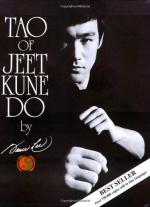
|
| Name: _________________________ | Period: ___________________ |
This test consists of 15 multiple choice questions and 5 short answer questions.
Multiple Choice Questions
1. What does Lee suggest Jeet Kune Do students should be alert to?
(a) Technical cunning.
(b) Interchangeable opposites.
(c) The rigidity of dual comprehension.
(d) Time and space.
2. According to Lee, how are the psychic hindrances of man and surroundings eliminated?
(a) Through a rigid martial arts practice.
(b) Through the process of mastering technical knowledge.
(c) Through living in harmony with nature.
(d) Through eliminating negative thoughts and feelings.
3. What does Lee say involves observing the opponent's habits, virtues, and faults?
(a) A character study.
(b) Selecting tactics.
(c) Scientific observation.
(d) Preliminary analysis.
4. What strategy does Lee use for avoiding a blow without moving the body out of range with straight leads and counters?
(a) Parrying.
(b) Punching.
(c) Ducking.
(d) Slipping.
5. Which Jeet Kune Do move drops the body forward from the waist under swings and hooks to the head?
(a) Slipping.
(b) Lunging.
(c) Sweeping.
(d) Ducking.
6. What does Lee teach is the purpose of a feint?
(a) To increase a fighter's arsenal.
(b) To use enough motion to deflect a blow.
(c) To reduce an opponent's coordination.
(d) To improve muscle function.
7. What does Lee say is the highest priority as techniques mastered are forgotten to float in totality?
(a) Discipline.
(b) Excitement.
(c) Concentration.
(d) Emptiness.
8. Lee says that the tools of Jeet Kune Do are at the center of an undefined circle whose circumference allows _____.
(a) A series of circles to become one.
(b) One to find peace within.
(c) Continuous expansion outward.
(d) One to spiral out of control.
9. Lee believes that footwork during fighting is preferable to _____.
(a) Parrying.
(b) Circling.
(c) Standing still.
(d) Upper body work.
10. What does Lee recommend combining with a parry when fighting an opponent who is faster, taller, or has longer reach?
(a) The feint.
(b) The croise.
(c) The step back.
(d) The beat.
11. What types of fighters does Lee describe as using techniques and tactics learned by repetition without considering the reason?
(a) Thoughtless.
(b) Mechanical.
(c) Beginners.
(d) Intellectual.
12. Lee says that the key element of Jeet Kune Do is its _____ that permits it to have all technique.
(a) Attention to detail.
(b) Teachers.
(c) Openness to ideas.
(d) Lack of technique.
13. How many diseases does Lee propose as desires that are attachments?
(a) Five.
(b) Six.
(c) Three.
(d) Two.
14. What does Lee call the space a fighter and his opponent have in relation to each other?
(a) Personal space.
(b) Two parts of a whole.
(c) Following distance.
(d) Fighting measure.
15. Lee believes one should keep his mind in a state of _____ so the freedom of action is never _____.
(a) Emptiness/Obstructed.
(b) Consciousness/Affected.
(c) Joy/Impacted.
(d) Contemplation/Disturbed.
Short Answer Questions
1. The _____ in the high line of engagement starts under the opponent's hand, and in the low line starts over the opponent's hand.
2. What move does Lee say can be used to open the line by force or to feint before an attack?
3. Compound attacks are characterized as _____ with short, fast combinations, or _____ with deep, penetrative, and fast combinations.
4. What technique does Lee describe that requires three factors be understood, including the opponent lead to determine the open side of the opponent?
5. What does Lee teach as a fast forceful backward movement that allows further retreat or stepping forward to attack?
|
This section contains 531 words (approx. 2 pages at 300 words per page) |

|




